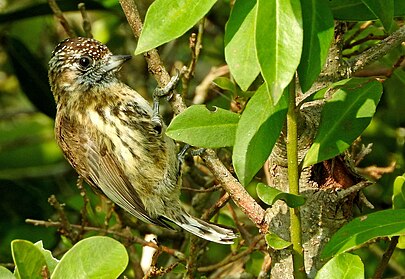Mottled piculet
| Mottled piculet | |
|---|---|

| |
| Adult male at Urupema, Santa Catarina state, Brazil | |
| Scientific classification | |
| Domain: | Eukaryota |
| Kingdom: | Animalia |
| Phylum: | Chordata |
| Class: | Aves |
| Order: | Piciformes |
| Family: | Picidae |
| Genus: | Picumnus |
| Species: | P. nebulosus
|
| Binomial name | |
| Picumnus nebulosus Sundevall, 1866
| |

| |
The mottled piculet (Picumnus nebulosus) is a
Taxonomy and systematics
The mottled piculet is

Description
The mottled piculet is 10 to 11 cm (3.9 to 4.3 in) long and weighs 11 to 12 g (0.39 to 0.42 oz). Adult males have a black cap and nape with a red patch on the forehead and white spots on the rest of it. Their face is mostly dark olive-brown with some white. Their hindneck and upperparts are warm olive-brown with a buff or rusty tinge on the back. Their flight feathers are dark brown to blackish with wide pale edges on the
Distribution and habitat
The mottled piculet has an almost unique range. It is found from southeastern Brazil's
Behavior
Movement
The mottled piculet is mostly sedentary but is thought to also make some elevational movements.[5]
Feeding
The mottled piculet forages in dense vegetation of the understory and also in trees up to about 8 m (26 ft) above the ground. It takes insect larvae from thin branches, vines, and bamboo stems. It usually forages alone but will join
Breeding
The mottled piculet's breeding season is from October to December. Nothing else is known about its breeding biology.[5]
Vocal and non-vocal sounds
The mottled piculet's vocalisations are limited to a repetitive "seep" or "cheep", sometimes linked into a brief trill, and an occasional humming sound. The alarm call is a shrill cricket-like whistling sound. It also drums, particularly on bamboo, in an irregular pattern of two to four rapid strikes.[4]
Status
The
References
- ^ . Retrieved 13 January 2023.
- ^ a b Gill, F.; Donsker, D.; Rasmussen, P., eds. (August 2022). "Woodpeckers". IOC World Bird List. v 12.2. Retrieved January 9, 2023.
- ^ Remsen, J. V., Jr., J. I. Areta, E. Bonaccorso, S. Claramunt, A. Jaramillo, D. F. Lane, J. F. Pacheco, M. B. Robbins, F. G. Stiles, and K. J. Zimmer. Version 24 July 2022. A classification of the bird species of South America. American Ornithological Society. https://www.museum.lsu.edu/~Remsen/SACCBaseline.htm retrieved July 24, 2022
- ^ ISBN 978-1770853096.
- ^ a b c d e f Winkler, H., D. A. Christie, and A. Bonan (2020). Mottled Piculet (Picumnus nebulosus), version 1.0. In Birds of the World (J. del Hoyo, A. Elliott, J. Sargatal, D. A. Christie, and E. de Juana, Editors). Cornell Lab of Ornithology, Ithaca, NY, USA. https://doi.org/10.2173/bow.motpic1.01 retrieved January 13, 2023


